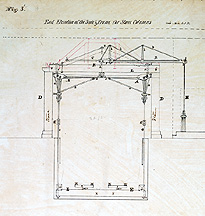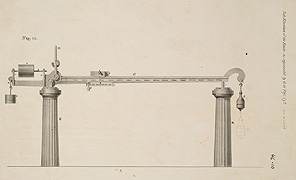
A weigh lock weighs cargo boats in order to determine the tolls owed. Boats weighed empty at the beginning of the season were then weighed when loaded with freight each trip, to determine net tonnage. The boat enters the lock, the water is drained, and the boat comes to rest on the scale. This large mechanism works like the balance scale in your doctor's office. The toll per ton differed with the nature of the cargo, and the state adjusted the tolls depending on the economic and political climate of the moment. There were seven weigh stations on the Erie Canal.
In the top drawing, boats would pass between the house and the Doric columns, which supported a roof over the scale. This can be better seen in the drawing on the left at the bottom (labeled End View), where the boats enter head on. The middle drawing (labeled Plan) shows the weigh lock and weigh lock house from above, with the location of the offices for the Superintendent, Weighmaster, and Collector indicated.
The foundations of this Greek Revival weigh station are still extant today in West Troy (now Watervliet). In the top drawing, boats would pass between the house and the Doric columns, which supported a roof over the scale. The scale itself, not pictured in this drawing, occupied the space between the columns and the building.
Scales were not used in the original weigh locks. As boat entered the weigh lock, the level of water in the lock rose, and by displacement the boat=s total weight was determined. Then the weight of the empty boat, which had been previously established, was subtracted to determine the weight of just the cargo. Shortly after the completion of the canal, new weigh locks at Syracuse and Troy were built to replace the original displacement locks. The new weigh locks, which abandoned the displacement method, were designed to be drained to place the boat directly on a wooden cradle that was attached to a scale mechanism. After the boat was weighed, water reentered the lock and the boat moved on.
With the enlargement of the canal, the size and weight of loaded boats increased. Squire Whipple, who designed many of the canal bridges, patented and built the first weighing lock scale to weigh 200 to 300 ton canal boats.
In sharp contrast with the initial concerns that the canal would be a financial black hole, it was an enormous financial success. By 1883, more than $121 million in tolls was collected, which totally covered the original construction costs, constant repairs, operation, and enlargement. Toll charges were discontinued that year because of the financial success of the Canal and, secondly, to sustain the economic viability of the communities along the route because of competition by the railroads.
The 1850 weigh lock building in Syracuse still stands, although the canal has been paved over, and serves today as the Erie Canal Museum.
 The plan to the right is one of four sections of scale used to weigh canal boats in a weigh lock.
This scale was located in West Troy, now Watervliet. In these diagrams, the scale used for
weighing cargo boats is seen from the perspective of a boat entering the weigh lock. The four
sections of the scale, virtually identical to each other, were located one after the other in a line.
When the water was removed, the boat would come to rest on the two planks marked "W" in the
diagram, which ran the length of the scale. As the heavy boat pulled the body of the scale down,
a crossbeam, "B", which pivots at "J", was pulled up at its right extremity, raising the rod "H",
which was attached to the scale's weigh beam. The weigh beam, which records the weight, is
perpendicular to the page and does not show in the diagram, although its support column appears
at the bottom of the rod "H".
The plan to the right is one of four sections of scale used to weigh canal boats in a weigh lock.
This scale was located in West Troy, now Watervliet. In these diagrams, the scale used for
weighing cargo boats is seen from the perspective of a boat entering the weigh lock. The four
sections of the scale, virtually identical to each other, were located one after the other in a line.
When the water was removed, the boat would come to rest on the two planks marked "W" in the
diagram, which ran the length of the scale. As the heavy boat pulled the body of the scale down,
a crossbeam, "B", which pivots at "J", was pulled up at its right extremity, raising the rod "H",
which was attached to the scale's weigh beam. The weigh beam, which records the weight, is
perpendicular to the page and does not show in the diagram, although its support column appears
at the bottom of the rod "H".
 The weigh beam in the plan to the left measures and displays the weight of the boat in a weigh
lock. Rod "H" coming down from crossbeam "B" in the companion diagram raises the weigh
beam. A weight is slid along this beam, as in modern balance scales, until the beam balances.
Each mark on the main beam represented a ton-up to 170 tons, or 340,000 pounds. For heavier
boats, an additional weight representing 100 tons, or 200,000 pounds could be hung from the
right end of the beam. Note the pencil sketch envisioning a second weight to counter-balance
another 100 tons.
The weigh beam in the plan to the left measures and displays the weight of the boat in a weigh
lock. Rod "H" coming down from crossbeam "B" in the companion diagram raises the weigh
beam. A weight is slid along this beam, as in modern balance scales, until the beam balances.
Each mark on the main beam represented a ton-up to 170 tons, or 340,000 pounds. For heavier
boats, an additional weight representing 100 tons, or 200,000 pounds could be hung from the
right end of the beam. Note the pencil sketch envisioning a second weight to counter-balance
another 100 tons.
http://www.eriecanal.org/UnionCollege/The_Weigh_Lock.html